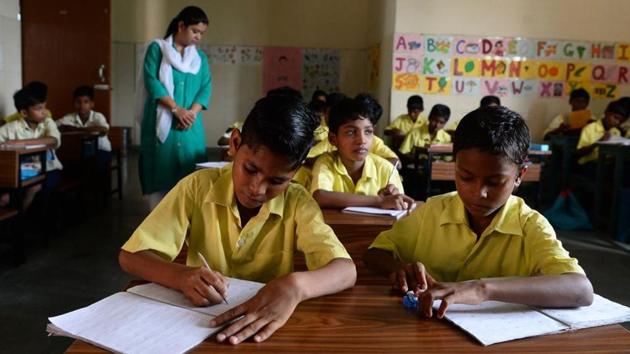7 ways to create a student centered classroom
The traditional classroom where students sit quietly and attentively in their seats, while the teacher pours vast amounts of wisdom and knowledge into their sponge like brains is over (assuming it ever existed.) This is especially true for middle school and high school classes where “teaching” can be a constant battle.
It just sort of sounds good as it rolls of the tongue, student-centered classroom. We’ve all heard the phrase coined before, yet most educators would agree that developing a student centered classroom is becoming more of a necessity and norm these days than a luxury or innovative new approach to teaching.

The traditional classroom where students sit quietly and attentively in their seats, while the teacher pours vast amounts of wisdom and knowledge into their sponge like brains is over (assuming it ever existed.) This is especially true for middle school and high school classes where “teaching” can be a constant battle.
So what exactly is a student-centered classroom? In short, a student-centered classroom, or student-centered learning environment, is one where the focus of instruction is shifted from the teacher to the student, with the end goal of developing students who are autonomous and independent, by placing the responsibility of learning in the hands of the students. Many proponents of student-centered learning would argue that it’s one of the most effective ways to help students develop the skills required for independent problem-solving and lifelong learning.
In the more traditional “teacher-centered learning” environment, the teacher is center of the learning experience and takes the “active” role of teaching, while the students assume a more “passive” or receptive role. In contrast, in the student-centered learning environment, the interests of the students’ take center stage and the teacher gives students choice and voice, finding ways to provide learning experiences that focus on what students value. In the student-centered classroom, students take a more “active” role in the education experience.
It doesn’t matter if you’re a kindergarten teacher, high school instructor or college professor, developing a student-centered learning environment will help your students become independent learners who will ultimately take charge of their own education-students who are curious, eager to learn, and willing to do whatever it takes to be successful.
Unfortunately, developing a student-centered learning environment isn’t always easy, especially if your experience frames learning in a more traditional way. For many, implementing a student-centered learning environment sounds great in theory, but putting it into practice is a different story. Below we’ll explore some strategies, principles and offer some proven tips that can make the student-centered learning environment a reality, and success, in your classroom.
In a traditional classroom, the teacher speaks, the students listen. In a student-centered classroom, the students speak, the teacher listens, interjects and facilitates conversation when needed, and then thanks the students for their participation. By involving students directly in the education process, and by enabling them to interact with one another, students begin to feel a sense of community. More importantly they are shown that what they feel, what they value, and what they think are what matter most. In the student-centered classroom, the teacher acts not only as educator, but as both facilitator and activator.
In more traditional approaches, the teacher stands in the front of the room lecturing while the students sit passively watching and (hopefully) listening. Students work individually, while cooperative learning is often discouraged. Thankfully, student centered instruction breaks through many of these boundaries, as this method of instruction focuses on the process of learning.
Student centered teaching shifts the focus from the teacher to the student. It encourages active participation on the part of the students and requires that they monitor their own thinking. Students are also expected to not only be conscious of their learning but to also assume responsibility. Student motivation generally increases with student centered learning, as does student achievement and overall satisfaction with the school experience.
There are many ways to incorporate student centered techniques into classroom resources and lessons:
1. Allow for student choice and autonomy
This might mean providing project, classroom and homework assignment options, as well as allowing students to design their own seating arrangements. Providing more types of question types in assessments also gives students the chance to make their own choices. Finally, encourage teachers to give the students a few minutes of downtime to use as they’d like (within reason of course).
2. Use open-ended questioning techniques
This practice encourages critical and creative thinking and enhances problem-solving skills. Open-ended questioning encourages clear communication and provides students with reassurance that their thoughts and ideas matter.
3. Engage in explicit instruction
Explicit instruction moves away from the skill and drill attitude of teaching. It is a much more direct and engaging method of instruction that pulls the students right into the heart of the lesson. Students are active participants in what is going on, rather than bystanders and onlookers.
4. Encourage student collaboration and group projects
When students work with each other they are learning a great deal more than just the lesson content. They are gaining an appreciation for the diversity that exists in our schools and communities. They are also learning to have respect for what may sometimes be very differing points of view. And finally, they are able to bounce their ideas back and forth with each other, creating a much greater opportunity to grow these ideas into something great.
5. Encourage student reflection
Student reflection allows students to slow things down a bit and take a step back to analyze things. It also allows time for their brains to process what they have been learning. Reflection creates space and time for individual and group growth.
6. Create individual self-paced assignments
All students don’t work at the same speed and assignments should reflect this. Allowing students to move through material at a rate that best fits their learning styles and needs makes it more likely that they will gain deeper understanding of the subject matter.
7. Get the students involved in community-based activities and service-learning projects
This helps students to see their important role in the larger world. They are given the chance to learn how valuable and fulfilling it can be to give back to others. Learning becomes more organic and less rigid. Students have the opportunity to see firsthand that learning opportunities surround us everywhere where we go.
Creating a more student centered classroom does not have to be hard for teachers
Your role as publisher can be of great help, as you incorporate many of these techniques right into the resources you are creating. See the students as an integral part of the learning process, and you’re on your way!
(Author Siddarth Rajgarhia is director of Delhi Public School, Nashik. Views expressed here are personal.)












